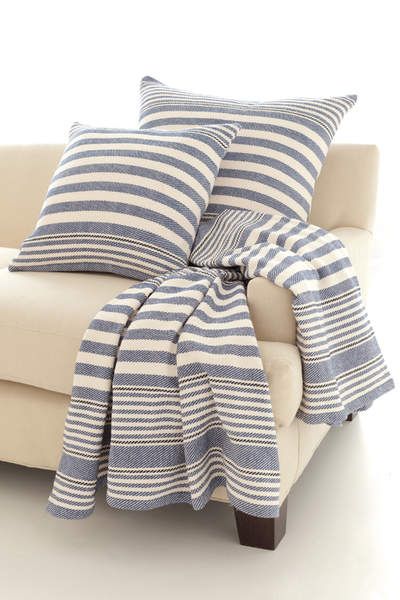18 Feb Woven Stripes: Types, Techniques & Applications
Stripes never seem to go out of fashion, and we are excited to see that replicate in the textile industry too. Today we’re going to give you a sneak peek into the technique and common types of woven stripes seen in home interiors.
Before we go ahead, here’s a little insight into the process.
Weaving is a method of fabric production in which two distinct sets of yarns or threads are interlaced at right angles to form a fabric or cloth. Cloth is usually woven on a loom, a device that holds the warp threads in place while filling threads are woven through them.
The way the warp and filling threads interlace with each other is called the weave. Woven cloth can be plain (in one colour or a simple pattern), or can be woven in decorative or artistic designs.
Types of weaves
The majority of woven products are created with one of four basic weaves: plain weave, basket weave, satin weave, or twill.
- Plain Weave

Source: www.sew4home.com
The most basic form of fabric construction, plain weave is a one-to-one overlap of Warp and Weft threads (the weft threads go over, then under, the warp threads). Also, they are inexpensive to produce & durable.
- Basket Weave

Source: www.sew4home.com
This is a simple variation of Plain Weave. In this version, the criss-cross pattern uses more than one thread, but the number of threads is consistent throughout. The result resembles a checkerboard, because the criss-crossing strands are more pronounced than in the Plain Weave
- Satin Weave
 Source: www.sew4home.com
Source: www.sew4home.com
Satin is known as a soft and smooth fabric that drapes wonderfully. To create this weave, one thread (either the Warp or the Weft) is ‘floated’ over four or more opposite threads. It then goes under one thread, and repeats the pattern. ‘Float’ is the term for spaces between interlacing – where a thread rests on top of the opposite thread. The large distance between interlacing is what creates the smooth and glossy surface on this fabric.
- Twill

Source: www.sew4home.com
Twill weaves are easy to spot since they create diagonal lines. The Weft thread is passed through the warp thread in groups of two or more. Each row of threads starts on the next line in a progression, creating a distinct diagonal line. This is generally rougher in texture , so they aren’t great for soft pillows or comforters.
Weaving Techniques
- Straight Sit

Source: www.loomandspindle.com.au
- Diagonal Sit

Source: www.loomandspindle.com.au
- Straight Interlock (Common Weft)

Source: www.loomandspindle.com.au
- Diagonal Interlock (Common Weft)

Source: www.loomandspindle.com.au
- Straight Interlock (Common Warp)

Source: www.loomandspindle.com.au
- Diagonal Interlock (Common Warp)

Source: www.loomandspindle.com.au
Applications in Home textiles
- Cushions

Source: www.pinterest.com
- Tablecloth

Source: www.etsy.com
- Comforters

Source: www.pinterest.com
- Table Runners

Source: www.keep.com

